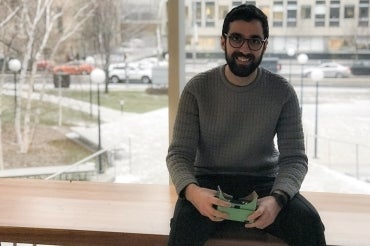U of T graduate student delivers first virtual reality biochemistry lecture

Published: December 12, 2017
A University of Toronto graduate student is believed to be the first to use virtual reality in a biochemistry research lecture – allowing audience members to immerse themselves in 3D to better understand how the eye uses light to create vision.
Aidin Balo, a PhD student in the department of biochemistry, worked with the software company Autodesk and his PhD supervisor, Professor Oliver Ernst, to prepare the lecture. The team then supplied the audience with cheap cardboard-based tools they could use with their smartphones to instantly access an immersive atmosphere for peering deeply into the human eye.
“Anybody can do it,” says Balo. The software is public and you can make the glasses with cardboard and two pieces of convex glass. Then all you need is a desktop computer to prepare the content and a smartphone for each person. The goal here is to make virtual reality more accessible.”
Balo and Ernst delivered the lecture to 200 people in 2016 at a conference in Berlin, and then to a larger audience at ShanghaiTech University, with support from Autodesk’s Merry Wang and the Canadian Institute for Advanced Research. Based on good audience feedback, the three wrote about their experience in this month’s issue of the journal Nature Methods.
“So many people came up to us afterwards,” he says. “It was such an overwhelmingly positive experience that I was surprised.”
In his lecture, as Balo described how the visual pigment in the eye changes its shape and signals in response to light, his audience watched examples of these changes in real time. By looking up, down or sideways, they could virtually circle around an entire protein, seeing the way it changed and how it worked in the eye. Balo realized that the experience made it easier for people outside his field of structural biology to understand how the first steps of vision work.
“Structural biologists would benefit from a virtual reality lecture, but so would those who are more interested in the bigger picture, but still need to know how molecules work,” he says. “Those could be biologists, chemists, physicists or even medical doctors.”
The Ernst lab at the Faculty of Medicine explores how light is converted to a chemical signal in the eye and how this signal is terminated. By understanding more about how the eye works to create vision, Balo hopes to learn more about when it fails to do so. He hopes that this research will contribute to future treatments for blindness.


